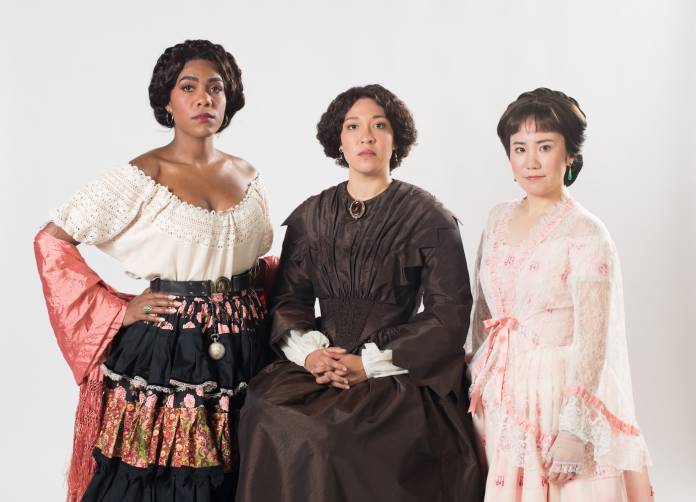ALL EARS After two decades of well-worn Gold Rush metaphors about Silicon Valley, we’re long overdue for a fresh take on a time period calcified in most peoples’ minds as some boisterous, Disney-esque romp, rife with (mostly white) 49er bromances, shady stereotypes, and lusty Madames with hearts of, well, gold.
While current HBO series Westworld adds dark, sci-fi undercurrents to the Wild West trope and recent HBO series Deadwood gave the frontier people of the 1800s some realistic curse-words and filthy predicaments, the California Gold Rush remains more of a sanitized theme park ride than the hugely consequential, environmentally degrading, murderous and politically momentous clash of cultures and value systems it was.
It was partly this frustration with the hokeyness of previous representations that drove director and librettist Peter Sellars to team up with minimalist composer John Adams and create Girls of the Golden West, a new work premiering at the San Francisco Opera (Tue/21-December 10 at the War Memorial Opera House, more info here.)

A couple years ago, Sellars was contacted by La Scala in Milan to direct a production of Puccini’s belovedly creaky 1910 La Fanciulla del West, aka The Girl of the Golden West, which did much to cement the stereotypes of the time in the international popular imagination.
As Sellars told the Washington Post, “Now anybody who knows me would not call and ask me to do that, but I did the research … and that libretto is pure popcorn. So I said to John, ‘Let’s have the great American opera about California.’”
For his part, Adams — whose 1987 Nixon in China was an absolute triumph when staged at SF Opera in 2012 — was drawn to the idea by his actual proximity to the subject matter. “I have a cabin in the Sierra Nevada Mountains not far from where these events in the opera took place. I know the terrain. I have hiked through those valleys and along those hillsides. This is home to me,” he says in the opera’s production notes.
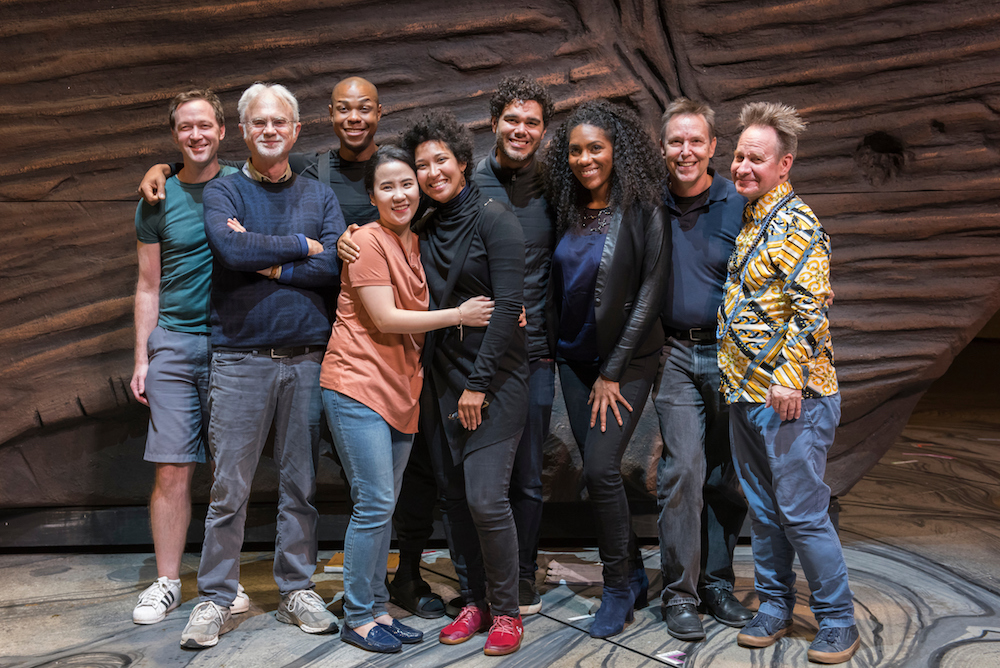
And while Girls of the Golden West may not completely change our idea of the period, it certainly adds necessary complexity, foregrounding stories of women and people of color inspired by actual historical record. The main thread is that of Dame Shirley, an educated woman who chronicles the rugged and tragic goings-on of a mining camp in 1851-52.
(Sellars’ libretto draws from The Shirley Letters, a collection of 23 letters by Louise Clappe penned under the name Dame Shirley — as well as the diary of Chilean miner Ramón Gil Navarro, Mark Twain’s Roughing It, memoirs of fugitive slaves, Chinese immigrants’ poems, and the Argentine poet Alfonsina Storni, among other texts.)
Help us save local journalism!
Every tax-deductible donation helps us grow to cover the issues that mean the most to our community. Become a 48 Hills Hero and support the only daily progressive news source in the Bay Area.
But there are several other characters, whose often-overlooked stories take center stage to Adams’ naturalistic, driving music, among designer David Gropman’s innovatively rustic sets. “The true stories of the forty-niners are overwhelming in their heroism, passion and cruelty,” Sellars says. “Telling tales of racial conflicts, colorful and humorous exploits, political strife and struggles to build anew a life and to decide what it would mean to be American.”
I spoke with two of the people who embody those tales in the production, J’Nai Bridges and Davóne Tines, about their unique characters, what it took to prepare to play them (Zumba! Who knew?), and the lessons this new opera about the Gold Rush can teach us today.
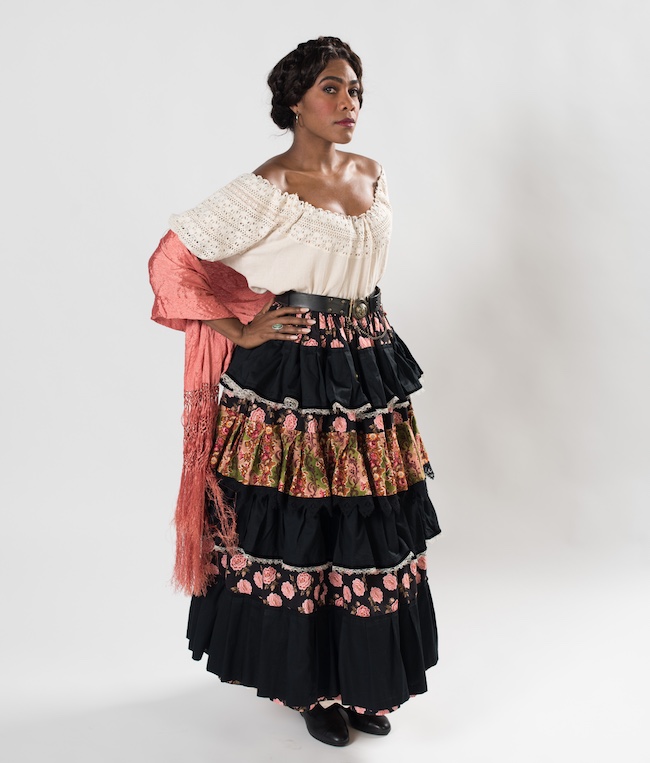
J’Nai Bridges, a mezzo-soprano from Washington who pivoted from a professional basketball career to opera, plays Josefa Segovia, a young Mexican woman who entertains at the Empire Hotel — and who also happens to be the first known woman lynched in California.
“This is a very special piece, one I’m connecting to deeply,” she told me over the phone. “I’m feeling a lot of pressure in terms of creating a brand new role — but I’m also not feeling pressure: I was specifically requested to be here for this role, and I’m excited and relieved because no one else’s voice is in my mind from previous performances.
“Josefa is involved in one of the love stories of the opera,” Bridges continued. “It’s not clear at first that I am in a relationship, but I am. For the first act I’m mostly silent. Josefa is onstage, observing and sitting back. She spends a lot of time listening to all the people in this opera, what’s going on in this mostly chaotic process of everyone looking for gold. She’s very observant and almost foresees what’s going to happen, the future and the outcome of the characters.
“But when she does have something to say, you don’t forget it! She reminds me of my grandmother in that way. She would sit back and observe, but when she said something I’d hear it in my head a few weeks later and say, wow!”

What was Bridges’ impression playing such a real-life person, freighted with such tragic significance?
“Her fate, in the opera as in life, is to be hanged, and I think she perceives that,” Bridges told me matter-of-factly. “It’s an interesting moment because she goes to her death with pride and resilience, and the feeling that she will be in a better place. Her predicament that she’s in is as a Mexican woman at the bottom of the totem pole of that society — telling her story is a very powerful statement that applies today.
“Josefa urges the people of that time to take a look in the mirror and rid themselves of darkness, to see themselves not just as humans with flesh in the world but also a human soul, Bridges said. “With all the violence in the world, then and now, that’s what we need to do.”
Girls of the Golden West tells so many stories of the Gold Rush that we’re unfamiliar with, especially those of women and people of color — was that something that attracted her to the part?
“I was attracted to the intersectional aspects of the story, the way so many different kinds of people came together in different ways, and also to the basic history and of course the music. We didn’t learn very much about the Gold Rush in school, we weren’t taught about the dark side of American history, but we’re where we are today because of the it. I’ve learned so much about this history. And being on this journey with colleagues I admire so much — not only singers, but real intellectuals — has been a spiritual experience.
“The music, too, is the story. John’s music is a compilation of so many styles: folk music, naturalistic music, the music of many times. I feel like I’m getting back to some of my roots while singing my piece. I’m an opera singer but I feel I can access different styles while still be categorized as a classical singer. I listen to my colleagues and I hear an individual experience that is so special through this music.”
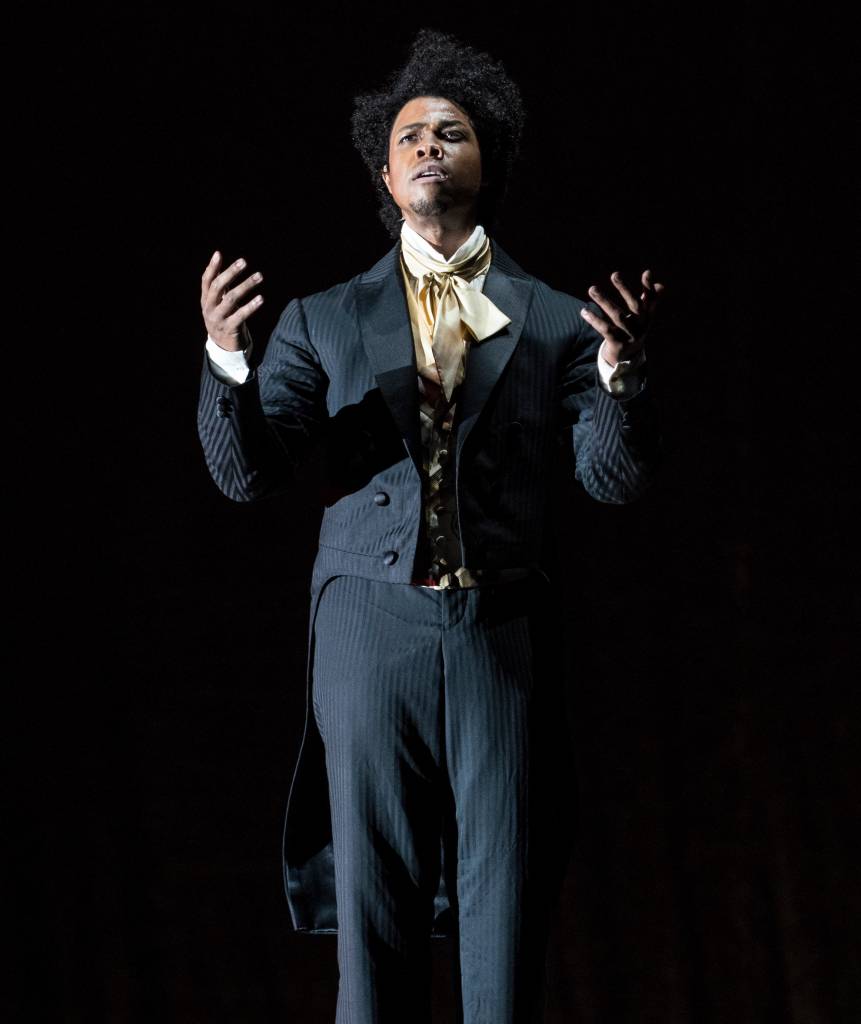
One of those colleagues is Davóne Tines, a bass-baritone originally from Virginia, now based in Baltimore. He’s worked with Sellars before, most recently on a production of Stravinsky’s Oedious Rex in Europe that was fully staged in a headlong three days. Tines plays Ned, “an African-American cowboy and fugitive slave who is drawn to the promise of the frontier.”
“Ned is a really interesting guy,” Tines told me over the phone. “Like many of Peter’s characters, he’s a concoction from different sources. One part is Paganini Ned, known as a kind of hustler in the general Wild West folklore. Then there’s a very real man named James Williams who was a fugitive slave: There’s an incredible book called The Fugitive Slave in the Gold Rush which is a first hand account of his life, and a lot of Ned’s words come directly from James Williams’ story. But it’s also combined with Frederick Douglass — Ned’s final aria is taken from Douglass’s “What to the slave is the Fourth of July” speech. So he’s quite a mix of things.
“Ned’s first song is a kind of Wild West nursery rhyme tune. It’s very playful, talking about stagecoach driving and fighting Indians. But then later on he becomes a more serious character who’s dealt with a lot of movement and adversity as James Williams’ words become more the focus of the character. And then he transforms into a great orator of the rank of Frederick Douglass, he’s got a breadth existence.”
How did Tines, who has been drawn to contemporary music, handle the music for this multiplicity of character?
“There are a lot of Gold Rush miners in the show, and they sing these amazing songs with text taken from very simple mining songs like ‘Doo-dah all the livelong day’ and the like,” Tines said with a laugh. “But John said he purposely got rid of the music; he took the rhythm and the words and breathed his own Adams life into them. There’s snippets of these tumbling, rhyming texts with colorful textures.
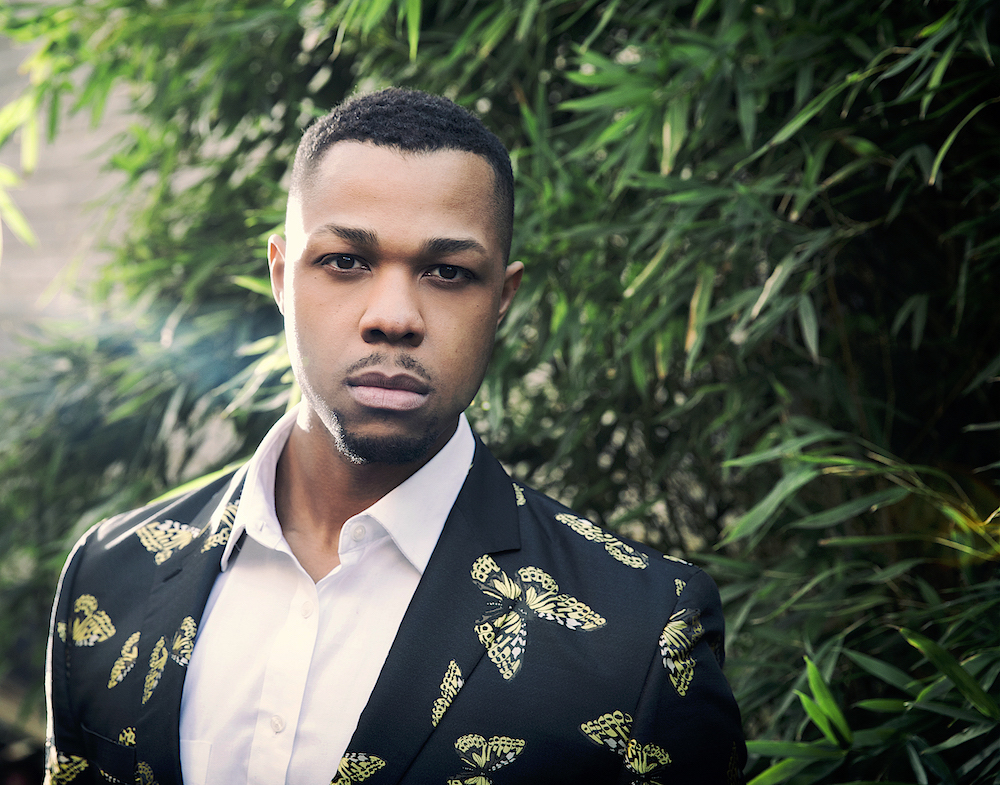
“For Ned, that means the playful words turn into the narration of driving a stage coach. There’s a part where the stagecoach goes off the rails, the horses go crazy, everything goes haywire, and Ned has to reel the whole thing in again in a clear and musical way. The first time I looked at the music I thought it was impossible. But as with a lot of John’s music, on the page it can seem crazy or a little different, because he’s really trying to capture a certain naturalism — which oddly, all by itself can look inorganic. But if you invest in it, it can feel really comfortable.
“The Frederick Douglass aria is a whole different side of John, akin to his famous “Batter My Heart,” where he takes very strong texts and allows it to speak naturally, but wraps it in interludes that are driven and powerful.”
With haywire stagecoaches, tumbling texts, and declamatory oration, Ned seems like a very physical role. What has Tines been doing to prepare?
“Working with Peter in general is a physical process,” Tines told me. “A lot of times he works in a very choreographic manner, and this time we’re trying to capture a natural style, with the help of incredible choreographer John Heginbotham. Also, a lot of people from the cast and production team, we go to Zumba together. Doug DaSilva at Fitness SF is our teacher, he does something special and intense.
“It’s necessary for me to do cardio every day in order to take on this role. One rule of thumb for me during rehearsals is that I get my heart rate to the place it’s going to be during the show. For this show, I need to do a whole workout in the gym so I can have a frame of reference for where the physicality can happen in performance.”
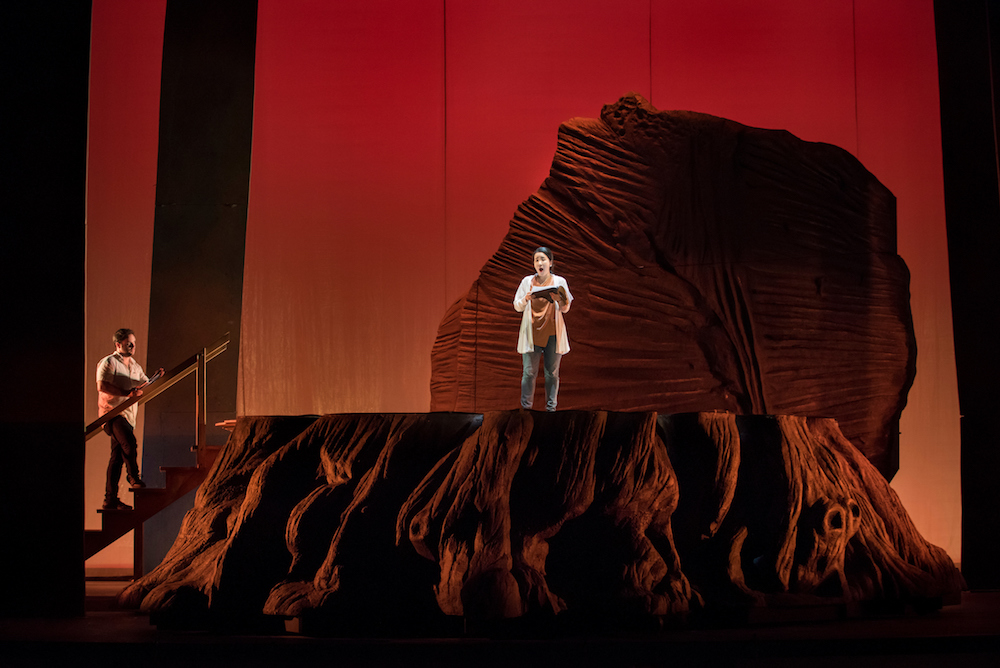
When most people think of the Gold Rush, there are usually a lot of hokey stereotypes involved — how is the production complicating what we think of that time period?
“This period is familiar in the worst way,” Tines told me. “The gold miners are akin to the seven dwarves, it’s a cartoonish way to think about the wild west. But Peter and John’s project — like Puccini’s Girl of the Golden West in his time — is to capture a certan kind of Americana. This time, as with the pluralization of ‘Girls,’ there’s a multiplicity of perspectives.
“This piece brings full color and 360 degrees to what it really might have been to live in this time, Tines said. “Part of the reality is diversity of experience, although everybody together is dealing with this strange environment, with trees that are bigger than anything they’ve ever seen and golden rocks in the ground. They’re dealing with each other, with so many people coming from all over the place, from different societal structures to the ‘Wild West’ with no rules, and hoping for the same thing.
“Everybody sorting themselves out is complicated, but they’re all on a trajectory that has so many depths and consequences that we still feel today.”
GIRLS OF THE GOLDEN WEST
A new opera at the San Francisco Opera
November 21-December 10
Tickets start at $26.
War Memorial Opera House
Tickets and more info here.


